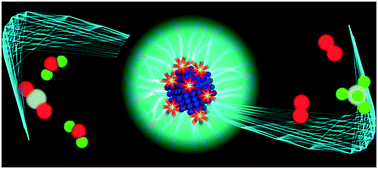当前位置:
X-MOL 学术
›
Catal. Sci. Technol.
›
论文详情
Our official English website, www.x-mol.net, welcomes your
feedback! (Note: you will need to create a separate account there.)
Bringing attention to metal (un)availability in encapsulated catalysts†
Catalysis Science & Technology ( IF 4.4 ) Pub Date : 2017-12-21 00:00:00 , DOI: 10.1039/c7cy01919j A. H. Habibi 1, 2, 3, 4 , R. E. Hayes 1, 2, 3, 4 , N. Semagina 1, 2, 3, 4
Catalysis Science & Technology ( IF 4.4 ) Pub Date : 2017-12-21 00:00:00 , DOI: 10.1039/c7cy01919j A. H. Habibi 1, 2, 3, 4 , R. E. Hayes 1, 2, 3, 4 , N. Semagina 1, 2, 3, 4
Affiliation

|
The study focuses on the determination of metal site availability in silica-encapsulated Pd catalysts (Pd@SiO2). Existing synthetic methods are modified to achieve a high metal loading (up to 6 wt%) and porosity (surface area of 700 m2 g−1) while maintaining the original Pd nanoparticle size of 8 nm. Two synthesis schemes are used for encapsulating Pd NPs, and the resulting catalysts are assessed in lean methane combustion at up to 823 K. Application of poly(vinylpyrrolidone) (PVP) as a Pd particle stabilizer and a potential porogen alone is concluded to be inadvisable as it results in catalysts with a surface area of 70 m2 g−1 that show extremely low activity due to Pd inaccessibility. The high-surface area materials (700 m2 g−1) prepared via a separate introduction of PVP and an additional porogen (cetyltrimethylammonium bromide, CTAB) are active and exhibit the same turnover frequencies as the traditional catalysts but require smaller reactor sizes because of the high metal loading. However, 2/3 of the Pd nanoparticle surface is blocked by the shell material even in the highly porous catalysts. The silica-encapsulated catalysts, thus, offer advantages of high mass-based activity and sintering resistance of the metal cores, but their high porosity must be ensured for efficient mass transfer by the addition of a porogen (such as CTAB) during the Stöber process. Above a certain limit, the increased amount of the porogen does not improve the metal accessibility and only leads to precious metal loss during synthesis.
中文翻译:

引起关注的是封装催化剂中的金属(不可用)†
该研究的重点是确定二氧化硅封装的Pd催化剂(Pd @ SiO 2)中金属位点的有效性。对现有的合成方法进行了修改,以实现高金属负载量(高达6 wt%)和孔隙率(表面积为700 m 2 g -1),同时保持原始的Pd纳米颗粒尺寸为8 nm。两种合成方案用于封装Pd NPs,并在高达823 K的贫甲烷燃烧中评估所得的催化剂。得出结论,不建议使用聚乙烯吡咯烷酮(PVP)作为Pd颗粒稳定剂和单独的潜在致孔剂。因为它会产生表面积为70 m 2 g -1的催化剂由于钯的不可及性而显示出极低的活性。(700米的高表面积材料2克-1制备)经由单独引入PVP和其他成孔剂(十六烷基三甲基溴化铵,CTAB)是有活性的,并且具有与传统催化剂相同的周转频率,但由于金属负载量高,因此需要较小的反应器尺寸。然而,即使在高度多孔的催化剂中,Pd纳米颗粒表面的2/3也被壳材料阻挡。因此,二氧化硅包封的催化剂具有基于质量的高活性和金属芯的耐烧结性的优点,但是必须确保其高孔隙率,以便在施托伯过程中通过添加致孔剂(例如CTAB)来有效地进行质量转移。超过一定的极限,成孔剂的增加不会改善金属的可及性,只会导致合成过程中的贵金属损失。
更新日期:2017-12-21
中文翻译:

引起关注的是封装催化剂中的金属(不可用)†
该研究的重点是确定二氧化硅封装的Pd催化剂(Pd @ SiO 2)中金属位点的有效性。对现有的合成方法进行了修改,以实现高金属负载量(高达6 wt%)和孔隙率(表面积为700 m 2 g -1),同时保持原始的Pd纳米颗粒尺寸为8 nm。两种合成方案用于封装Pd NPs,并在高达823 K的贫甲烷燃烧中评估所得的催化剂。得出结论,不建议使用聚乙烯吡咯烷酮(PVP)作为Pd颗粒稳定剂和单独的潜在致孔剂。因为它会产生表面积为70 m 2 g -1的催化剂由于钯的不可及性而显示出极低的活性。(700米的高表面积材料2克-1制备)经由单独引入PVP和其他成孔剂(十六烷基三甲基溴化铵,CTAB)是有活性的,并且具有与传统催化剂相同的周转频率,但由于金属负载量高,因此需要较小的反应器尺寸。然而,即使在高度多孔的催化剂中,Pd纳米颗粒表面的2/3也被壳材料阻挡。因此,二氧化硅包封的催化剂具有基于质量的高活性和金属芯的耐烧结性的优点,但是必须确保其高孔隙率,以便在施托伯过程中通过添加致孔剂(例如CTAB)来有效地进行质量转移。超过一定的极限,成孔剂的增加不会改善金属的可及性,只会导致合成过程中的贵金属损失。











































 京公网安备 11010802027423号
京公网安备 11010802027423号